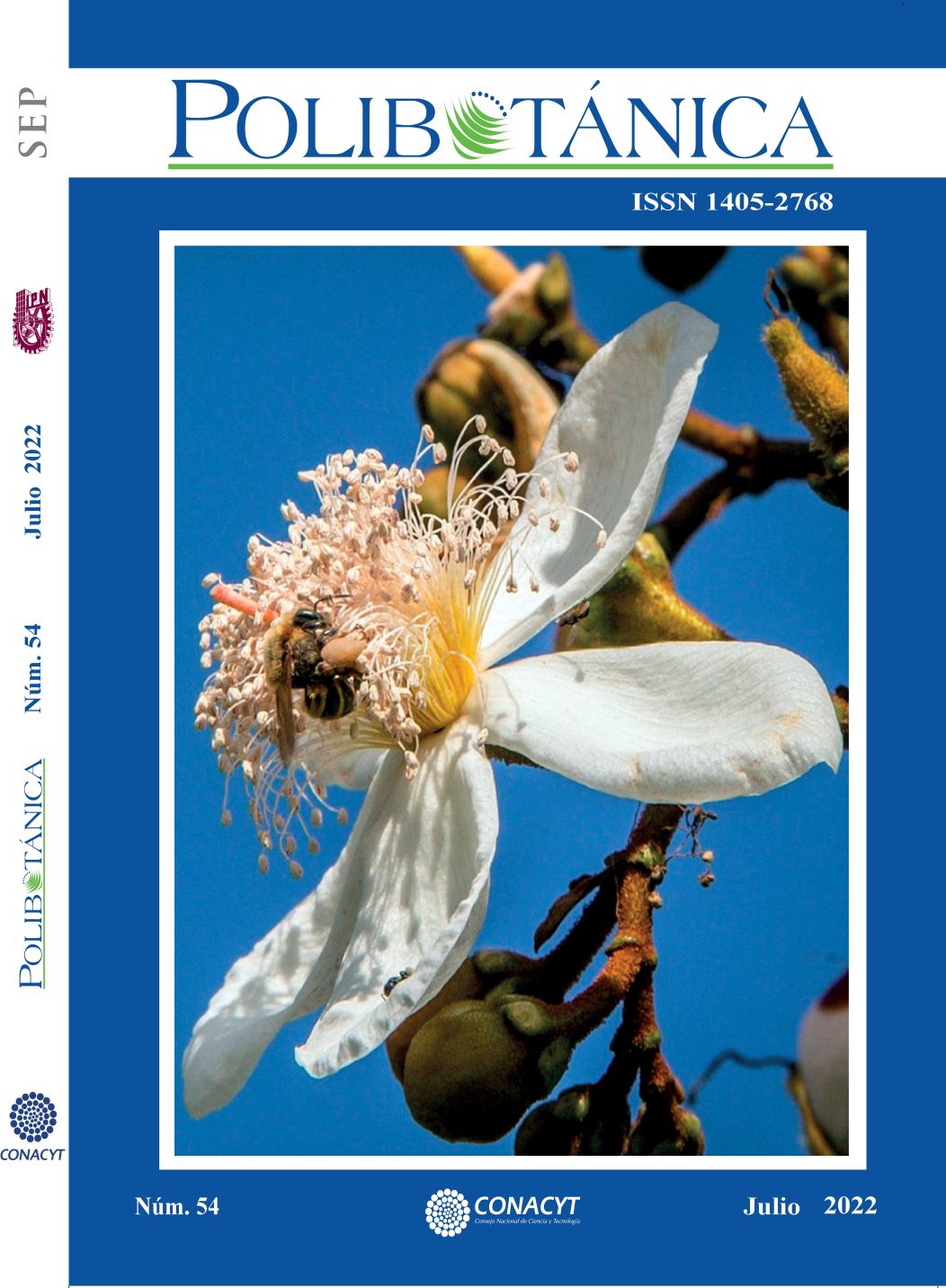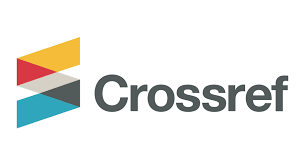Micropropagation of Agave maximiliana Baker by axillary shoot proliferation
DOI:
https://doi.org/10.18387/polibotanica.54.9Keywords:
in vitro propagation, raicilla mescal, growth regulators, maguey, ex vitro establishmentAbstract
Mexico is the center of the largest riches and domestication of Agave species; 20 of these are used as a source for the production of fermented and distilled spirits, including Agave maximiliana Baker, which is harvested in the field just before its sexual reproductive stage to make raicilla mescal, with the consequent constant decrease of its wild populations. The objective of this study was to develop an efficient protocol for in vitro mass micropropagation of this species through auxiliary shoot proliferation. Axillary shoots were induced using a three-factor experimental design, consisting of the following factors: 1) auxin 2,4-dichlorophenoxyacetic (2,4-D) in four different doses: 0, 0.01, 0.02, and 0.03 mg L-1; 2) cytokinin, 6-benzyladenine (BA) in doses of 0, 4, 8, and 12 mg L-1, and 3) two G1 and G6 genotypes. The dose of 12 mg L-1 BA in combination with 0.02 mg L-1 2,4-D produced 26.93 new shoots (p = 0.000) with a high-quality typical morphology, an essential characteristic for their separation and subsequent ex vitro establishment. Likewise, in order to attain the best production of long, branched, nonephemeral roots from these shoots, three genotypes (G1, G3, and G6) and three rooting treatments (with different concentrations of sucrose, activated charcoal, and/or indole-3-butyric acid) were assessed in vitro. The analysis of the results shows a need to add 9 % sucrose (p=0.000), i.e. 3 % more than the usual amount. Furthermore, the best ex vitro adaptation was found to be related to the genotype of the original plant, and there were significant differences in the width (p=0.023) and length (p=0.009) of the leaves.
References
Aureoles-Rodríguez, F., Rodríguez-de la O, J. L., Legaria-Solano, J. P., Sahagún-Castellanos, J., & Peña Ortega, M. G. (2008). Propagación in vitro del “maguey bruto” (Agave inaequidens Koch), una especie amenazada de interés económico. Rev. Chapingo Serie Hort. 14: 263-269.
Barreto, R., Nieto-Sotelo, J., & Cassab, G. I. (2010). Influence of plant growth regulators and water stress on ramet induction, rosette engrossment, and fructan accumulation in Agave tequilana Weber var. Azul. Plant Cell Tiss. Org. 103: 93-101. https://doi.org/10.1007/s11240-010-9758-9
Bellon, R.M., Barrientos-Priego, A. F., Colunga-García, M. P., Perales, H., Reyes, J. A., Rosales, S. R., & Zizumbo-Villarreal, D. (2009). Diversidad y conservación de recursos genéticos en plantas cultivadas, en: Capital natural de México, vol II: Estado de conservación y tendencias de cam-bio. CONABIO, México. pp. 355-382.
Binh, L. T., Muoi, L. T., Oanh, H. T. K., Thang, T. D., & Phong, D. T. (1990). Rapid propagation of agave by in vitro tissue culture. Plant Cell Tiss. Org. 23: 67-70.
Cabrera-Toledo, D., Vargas-Ponce, O., Ascencio-Ramírez, S., Valdez-Sandoval, L. M., Pérez-Alquicira, J., Morales-Saavedra, J., & Huerta-Galván, O. F. (2020). Morphological and genetic variation in monocultures, forestry systems and wild populations of Agave maximiliana of Western México: Implications for its conservation. Front. Plant Sci. 11: 817. https://doi.org/ 10.3389/fpls.2020.00817
Chávez-Guerrero, L., Flores, J., & Kharissov, B. I. (2010). Recycling of ash from mezcal industry: A renewable source of lime. Chemosphere 81: 633-638. https://doi.org/10.1016/j.chemosphere.2010.08.042
Chávez-Ortiz, L. I., Morales-Domínguez, J. F., Rodríguez-Sahagún, A., & Pérez-Molphe-Balch, E. (2021). In vitro propagation of Agave guiengola Gentry using semisolid médium and temporary immersion bioreactors. Phyton. 90: 1003-1013. https://doi.org/10.32604/phyton.2021.012862
Chen, Y., Chen, X., Hu, F., Yang, H., Yue, L., Trigiano, R. N., & Cheng, Z-M. (2014). Micropropaga-tion of Agave americana. Hortscience 49: 320-327.
Colunga-GarcíaMarín, P., Zizumbo-Villarreal, D., & Martínez-Torres, J. (2007). Tradiciones en el aprovechamiento de los agaves mexicanos: una aportación a la protección legal y conservación de su diversidad biológica y cultural. En: En lo ancestral hay futuro: del tequila, los mezcales y otros agaves, Colunga-GarcíaMarín, P., A. Larqué, L. E. Eguiarte y D. Zizumbo-Villareal (Eds.). Centro de Investigación Científica de Yucatán, pp. 229-248.
Delgado-Aceves, L., González-Arnao, M. T., Santacruz-Ruvalcaba, F., Folgado, R., & Portillo, L. (2021). Indirect somatic embryogenesis and cryopreservation of Agave tequilana Weber cultivar “Chato”. Plants. 10: 249. https://doi.org/10.3390/plants10020249
Diario Oficial de la Federación. (2019), Declaración General de Proteccción de la Denominación de Origen “Raicilla”. En línea (acceso 1 de junio de 2020): https://dof.gob.mx/nota_detalle.php?codigo=5564454&fecha=28/06/2019&print=true
Domínguez, R. M. S., González, L. J. M., Rosales, G. C., Quiñonez, V. C., Delgadillo, D. S., Mireles, J. O. S., & Pérez, M. B. E. (2008). El cultivo in vitro como herramienta para el aprovechamiento, mejoramiento y conservación de especies del género Agave. Investigación y Ciencia de la Uni-versidad Autónoma de Aguascalientes. 41: 53-62.
Eggli, U. (2001). Illustrated handbook of succulent plants: Monocotyledons. Urs Eggli (Ed.). Springer, New York. p. 400.
García-Mendoza, A. (1998). Con sabor a maguey. Guía de la colección nacional de Agaváceas y Noli-náceas del Jardín Botánico del Instituto de Biología de la UNAM. Edit. Sistemas de Informa-ción Geográfica. S. A. de C. V. UNAM. p. 114.
García-Mendoza, A. (2007). Los agaves de México. Ciencias 87: 14-23.
García-Mendoza, A. J., Franco-Martínez, I. S., & Sandoval-Gutiérrez, D. (2019). Cuatro especies nue-vas de Agave (Asparagaceae, Agavoideae) del sur de México. Acta Bot. Mex. 126: e1461. https://doi.org/ 10.21829/abm126.2019.1461
Garriga, C. M., González, O. G., Alemán, G. S., Abreu, C. E., Quiroz, B. K., Caligari, P. D. S., & Gar-cía-González, R. (2010). Management of auxin-cytokinin interactions to improve micropropa-gation protocol of henequén (Agave fourcroydes Lem.). Chil. J. Agr. Res. 70: 545-551.
Gentry, H. S. (1976). La simbiosis hombre-agave. Cact. Suc. Mex. 21(1): 16-28.
Hazra, S. K, Das, S., & Das, A. K. (2002). Sisal plant regeneration via organogenesis. Plant Cell Tiss. Org. 70: 235-240. https://doi.org/10.1023/A:1016517617039
Kumar, A., Sood, A., Palni, L. M. S., & Gupta, A. K. (1999). In vitro propagation of Gladiolus hy-bridus Hort.: Synergistic effect of heat shock and sucrose on morphogenesis. Plant Cell Tiss. Org. 57: 105-122. https://doi.org/10.1023/A:1006373314814
Martínez-Palacios, A., Ortega-Larrocea, M. P., Chávez, V. M., & Bye, R. (2003). Somatic embryogen-esis and organogenesis of Agave victoriae-reginae: Considerations for its conservation. Plant Cell Tiss. Org. 74: 135-142. https://doi.org/10.1023/A:1023933123131
Murashige, T., & Skoog, F. (1962). A revised medium for rapid growth and bioassays with tobacco tissue cultures. Physiol. Plantarum 15: 473-497.
Monja-Mio, K. M., & Robert, M. L. (2013). Direct somatic embryogenesis of Agave fourcroydes Lem. through thin cell layer culture. In Vitro Cell. Dev.-Pl. 49: 541-549. https://doi.org/10.1007/s11627-013-9535-7
Monja-Mio, K. M., Olvera-Casanova, D., Herrera-Alamillo, M. A., Sánchez-Teyer, F. L., & Robert. M. L. (2021). Comparison of conventional and temporary immersion systems on micropropagation (multiplication phase) of Agave angustifolia Haw. “Bacanora”. 3 Biotech. 11: 77. https://doi.org/10.1007/s13205-020-02604-8
Nikam, T. D., Mulye, K. V., Chambhare, M. R., Nikule, H. A., & Ahire, M. L. (2019). Reduction in hyperhydricity and improvement in in vitro propagation of commercial hard fibre and medicinal glycoside yielding Agave sisalana Perr. ex Engelm by NaCl and polyethylene glycol. Plant Cell Tiss. Org. Cult. 138: 67-78. https://doi.org/10.1007/s11240-019-01603-9
Pérez-Zavala, M. L., Hernández-Arzaba, J. C., Bideshi, D. K., & Barboza-Corona, J. F. (2020). Agave: a natural renewable resource with multiple applications. J. Sci. Food Agric. 100: 5324-5333. https://doi.org/10.1002/jsfa.10586
Portillo, L., Santacruz-Ruvalcaba, F., Gutiérrez-Mora, A., & Rodríguez-Garay, B. (2007). Somatic em-bryogenesis in Agave tequilana Weber. In Vitro Cell. Dev.-Pl. 43: 569-575. https://doi.org/10.1007/s11627-007-9046-5
Portillo, L., Santacruz-Ruvalcaba, F., & Olmedilla, A. (2012). Cellular and molecular changes associ-ated with somatic embryogenesis induction in Agave tequilana. Protoplasma 249: 1101-1107. https://doi.org/10.1007/s00709-11-0354-6
Puente-Garza, C. A., Gutiérrez-Mora, A., & García-Lara S. (2015). Micropropagation of Agave salmiana: Means to production of antioxidant and bioactive principles. Fron. Plant Sci. 6: 1026. https://doi.org/10.3389/fpls.2015.01026
Ragonezi, C., Klimaszewska, K., Castro, M. R., Lima, M., de Oliveira, P., & Zavattieri, M. A. (2010). Adventitious rooting of conifers: Influence of physical and chemical factors. Trees. 24: 975-992. https://doi.org/10.1007/s00468-010-0488-8
Ramírez-Malagón, R., Borodanenko, A., Pérez-Moreno, L., Salas-Araiza, M. D., Nuñez-Palenius, H. G., & Ochoa-Alejo, N. (2008). In vitro propagation of three Agave species used for liquor distil-lation and three for landscape. Plant Cell Tiss. Org. Cult. 94: 201-207. https://doi.org/10.1007/s11240-008-9405-x
Reyes-Díaz, J. I., Arzate-Fernández, A. M., Piña-Escutia, J. L., & Vázquez-García L. M. (2017). Media culture factors affecting somatic embryogenesis in Agave angustifolia Haw. Ind. Crop. Prod. 108: 81-85. https://doi.org/10.1016/j.indcrop.2017.06.021
Ríos-Ramírez, S. C., Enríquez-del Valle, J. R., Rodríguez-Ortiz, G., & Ruíz-Luna, J. (2017). Benzyla-minopurine and indol-3-acetic acid concentrations in in vitro proliferation of Agave angustifolia adventitious shoots. Cin. Inv. Agr. 44: 285-294. https://doi.org/10.7764/rcia.v44i3.1810
Robert, M. L., Herrera-Herrera, J. L., Castillo, E., Ojeda, G., & Herrera-Alamillo, M. A. (2006). An efficient method for the micropropagation of Agave species. Plant Cell Culture Protocols 318: 165-178. https://doi.org/10.1385/1-59259-959-1:165
Robert, M. L., Herrera-Herrera, J. L., Chan, J. L., & Contreras, F. (1992). Micropropagation of Agave spp. In: Biotechnology in Agriculture and Forestry. High-tech and Micropropagation III II 9, vol. 19, Bajaj, Y.P.S. (Ed.). Springer-Verlag, Berlin, pp. 306-332.
Rodríguez-Garay, B., Gutiérrez-Mora, A., & Acosta-Dueñas, B. (1996). Somatic embryogenesis of Agave victoria-reginae Moore. Plant Cell Tiss. Org. Cult. 46: 85-87. https://doi.org/10.1007/BF00039700
Santacruz-Ruvalcaba, F., & Portillo, L. (2009). Thin cell suspension layer as a new methodology for somatic embryogenesis in Agave tequilana Weber cultivar azul. Ind. Crop. Prod. 29: 609-614. https://doi.org/10.1016/j.idcrop.2008.12.001
Santamaría, J. M., Herrera-Herrera, J. L., & Robert, M. L. (1995). Stomatal physiology of a microprop-agated CAM plant; Agave tequilana (Weber). Plant Growth Regul. 16: 211-214. https://doi.org/10.1007/BF00024776
Torres, I., Casas, A., Vega, E., Martínez-Ramos, M., & Delgado-Lemus, A. (2015). Population dynam-ics and sustainable management of mescal agaves in central México: Agave potatorum in the Tehuacán-Cuicatlán Valley. Econ. Bot. 69: 26-41. https://doi.org/10.1007/s12231-014-9295-2
Valenzuela-Sánchez, K. K., Juárez-Hernández, R. E., Cruz-Hernández, A., Olalde-Portugal, V., Val-verde, M. E., & Paredes-López, O. (2006). Plant regeneration of Agave tequilana by indirect organogenesis. In Vitro Cell. Dev. -Pl. 42: 336-340. https://doi.org/10.1079/IVP2006788
Vázquez-García, J. A., Cházaro, M. J., Hernández, G., Vargas-Rodríguez, Y. L., & Zamora, M. P. (2007). Taxonomía del género Agave en el occidente de México: Una panorámica preliminar. In: Agaves del Occidente de México, Vázquez-García, J.A., M.J. Cházaro, G. Hernández, E. Flores y Y.L. Vargas-Rodríguez (eds.), Universidad de Guadalajara, pp. 38-82.
Zhang, Y-M., Li, L. X., Chen, Z., Li, J-F, Lu, J-Y., & Zhou, W-Z. (2013). Shoot organogenesis and plant regeneration in Agave hybrid, No. 11648. Sci Hortic-Amsterdam 161: 30-34. https://doi.org/10.1016/j.scientia.2013.06.047
Downloads
Published
Issue
Section
License

Polibotánica by Departamento de Botánica de la Escuela Nacional de Ciencias Biológicas del Instituto Politécnico Nacional se distribuye bajo una Licencia Creative Commons Atribución-NoComercial-CompartirIgual 4.0 Internacional.




















